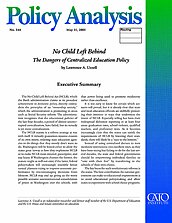The No Child Left Behind Act (NCLB), which the Bush administration claims as its proudest achievement in domestic policy, directly contradicts the principles of an “ownership society,” which the administration is promoting in areas such as Social Security reform. The administration recognizes that the educational policies of the last four decades, a period of almost uninterrupted centralization, have failed, but its remedy is yet more centralization.
The NCLB statute is a reform strategy at war with itself. It virtually guarantees massive evasion of its own intent, ordering state education agencies to do things that they mostly don’t want to do. Washington will be forced either to allow the states great leeway in how they implement NCLB or to make NCLB more detailed, prescriptive, and top-heavy. If Washington chooses the former, the statute might as well not exist; if the latter, federal policymakers will increasingly resemble Soviet central planners trying to improve economic performance by micromanaging decisions from Moscow. NCLB may end up giving us the worst possible scenario: unconstitutional consolidation of power in Washington over the schools, with that power being used to promote mediocrity rather than excellence.
It is too early to know for certain which scenario will prevail, but it is already clear that state and local education officials are skillfully protecting their interests in ways that undermine the intent of NCLB. Especially telling has been their widespread dishonest reporting in at least four areas: graduation rates, school violence, qualified teachers, and proficiency tests. As it becomes increasingly clear that the states can satisfy the requirements of NCLB by lowering their standards, there will likely be a “race to the bottom.”
Instead of using centralized decrees to turn mediocre institutions into excellent ones, as they have been trying but failing to do for the last several decades, the state and federal governments should be empowering individual families to “vote with their feet” by transferring to the schools of their own choice.
The key locus for such revolutionary reforms is the states. The best contribution the national government can make to educational improvement is to avoid educational policymaking and allow states to experiment with school choice programs.
About the Author

This work is licensed under a Creative Commons Attribution-NonCommercial-ShareAlike 4.0 International License.
